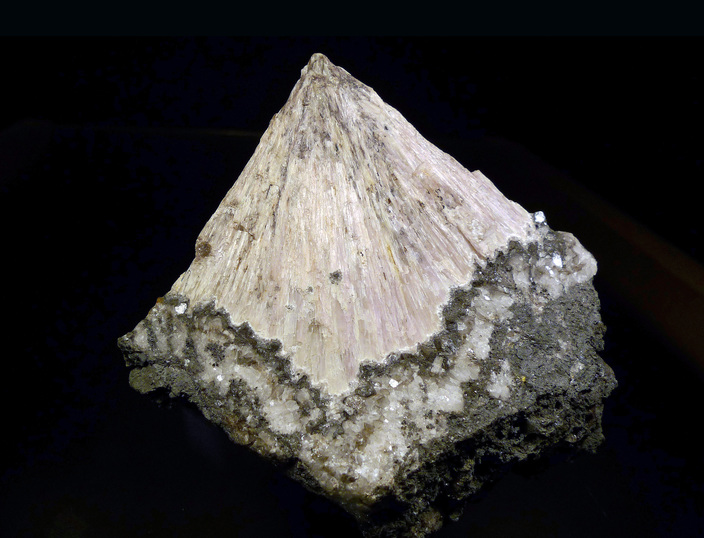Mendipite
A valid IMA mineral species - grandfathered
This page is currently not sponsored. Click here to sponsor this page.
About Mendipite
Formula:
Pb3Cl2O2
Colour:
Colourless, white, grey, often tinged yellow, blue, red; nearly colourless in transmitted light
Lustre:
Adamantine, Resinous, Silky, Pearly
Hardness:
2½ - 3
Specific Gravity:
7.24
Crystal System:
Orthorhombic
Name:
After the type locality at the Mendip Hills, Somerset, England, UK.
Type Locality:
Unique Identifiers
Mindat ID:
2641
Long-form identifier:
mindat:1:1:2641:9
GUID
(UUID V4):
(UUID V4):
252206e1-0095-4d2a-b890-bbbb9463bec2
IMA Classification of Mendipite
Approved, 'Grandfathered' (first described prior to 1959)
IMA Formula:
Pb3O2Cl2
Classification of Mendipite
3.DC.70
3 : HALIDES
D : Oxyhalides, hydroxyhalides and related double halides
C : With Pb (As,Sb,Bi), without Cu
3 : HALIDES
D : Oxyhalides, hydroxyhalides and related double halides
C : With Pb (As,Sb,Bi), without Cu
10.3.1.1
10 : OXYHALIDES AND HYDROXYHALIDES
3 : A3(O,OH)2Xq
10 : OXYHALIDES AND HYDROXYHALIDES
3 : A3(O,OH)2Xq
8.8.5
8 : Halides - Fluorides, Chlorides, Bromides and Iodides; also Fluoborates and Fluosilicates
8 : Halides of Pb
8 : Halides - Fluorides, Chlorides, Bromides and Iodides; also Fluoborates and Fluosilicates
8 : Halides of Pb
Mineral Symbols
As of 2021 there are now IMA–CNMNC approved mineral symbols (abbreviations) for each mineral species, useful for tables and diagrams.
| Symbol | Source | Reference |
|---|---|---|
| Mdi | IMA–CNMNC | Warr, L.N. (2021). IMA–CNMNC approved mineral symbols. Mineralogical Magazine, 85(3), 291-320. doi:10.1180/mgm.2021.43 |
Physical Properties of Mendipite
Adamantine, Resinous, Silky, Pearly
Transparency:
Transparent, Translucent
Colour:
Colourless, white, grey, often tinged yellow, blue, red; nearly colourless in transmitted light
Streak:
White
Hardness:
2½ - 3 on Mohs scale
Cleavage:
Perfect
On {110} perfect; {100} and {010} less perfect.
On {110} perfect; {100} and {010} less perfect.
Fracture:
Irregular/Uneven, Conchoidal
Density:
7.24 g/cm3 (Measured) 7.22 g/cm3 (Calculated)
Optical Data of Mendipite
Type:
Biaxial (+/-)
RI values:
nα = 2.240 nβ = 2.270 nγ = 2.310
2V:
Measured: 90° , Calculated: 84°
Max Birefringence:
δ = 0.070

Image shows birefringence interference colour range (at 30µm thickness)
and does not take into account mineral colouration.
and does not take into account mineral colouration.
Surface Relief:
Very High
Dispersion:
relatively strong
Optical Extinction:
Parallel. X = a; Y = b; Z = c.
Chemistry of Mendipite
Mindat Formula:
Pb3Cl2O2
Elements listed:
Crystallography of Mendipite
Crystal System:
Orthorhombic
Class (H-M):
2 2 2 - Disphenoidal
Space Group:
P21 21 21
Cell Parameters:
a = 9.52 Å, b = 11.87 Å, c = 5.87 Å
Ratio:
a:b:c = 0.802 : 1 : 0.495
Unit Cell V:
663.32 ų (Calculated from Unit Cell)
Z:
4
Morphology:
Fibrous or columnar masses, often radiated.
Crystal Structure
Load
Unit Cell | Unit Cell Packed
2x2x2 | 3x3x3 | 4x4x4
Unit Cell | Unit Cell Packed
2x2x2 | 3x3x3 | 4x4x4
Show
Big Balls | Small Balls | Just Balls | Spacefill
Polyhedra Off | Si Polyhedra | All Polyhedra
Remove metal-metal sticks
Big Balls | Small Balls | Just Balls | Spacefill
Polyhedra Off | Si Polyhedra | All Polyhedra
Remove metal-metal sticks
Display Options
Black Background | White Background
Perspective On | Perspective Off
2D | Stereo | Red-Blue | Red-Cyan
Black Background | White Background
Perspective On | Perspective Off
2D | Stereo | Red-Blue | Red-Cyan
View
CIF File Best | x | y | z | a | b | c
CIF File Best | x | y | z | a | b | c
Rotation
Stop | Start
Stop | Start
Labels
Console Off | On | Grey | Yellow
Console Off | On | Grey | Yellow
Data courtesy of the American Mineralogist Crystal Structure Database. Click on an AMCSD ID to view structure
| ID | Species | Reference | Link | Year | Locality | Pressure (GPa) | Temp (K) |
|---|---|---|---|---|---|---|---|
| 0006898 | Mendipite | Krivovichev S V, Burns P C (2001) Crystal chemistry of lead oxide chlorides. I. Crystal structures of synthetic mendipite, Pb3O2Cl2, and synthetic damaraite, Pb3O2(OH)Cl European Journal of Mineralogy 13 801-809 | 2001 | 0 | 293 |
CIF Raw Data - click here to close
X-Ray Powder Diffraction
Image Loading
Radiation - Copper Kα
Data courtesy of RRUFF project at University of Arizona, used with permission.
Powder Diffraction Data:
| d-spacing | Intensity |
|---|---|
| 7.40 Å | (60) |
| 3.78 Å | (60) |
| 3.51 Å | (70) |
| 3.08 Å | (60) |
| 3.04 Å | (80) |
| 2.78 Å | (100) |
| 2.64 Å | (90) |
Comments:
Låangban, Sweden.
Geological Environment
Paragenetic Mode(s):
| Paragenetic Mode | Earliest Age (Ga) |
|---|---|
| Stage 7: Great Oxidation Event | <2.4 |
| 47g : [Halogen-bearing surface weathering minerals] | |
| 47h : [Near-surface oxidized, dehydrated minerals] | |
| Stage 10b: Anthropogenic minerals | <10 Ka |
| 56 : Slag and smelter minerals (see also #51 and #55) |
Type Occurrence of Mendipite
General Appearance of Type Material:
Radiating masses of pale straw-yellow prismatic crystals and cleavages.
Associated Minerals at Type Locality:
Synonyms of Mendipite
Other Language Names for Mendipite
French:Plomb chloruré
Russian:Мендипит
Simplified Chinese:白氯铅矿
Spanish:Churchillita
Mendipita
Mendipita
Swedish:Saltsyradt Bly
Traditional Chinese:白氯鉛礦
Common Associates
Associated Minerals Based on Photo Data:
| 38 photos of Mendipite associated with Chloroxiphite | Pb3CuO2Cl2(OH)2 |
| 23 photos of Mendipite associated with Calcite | CaCO3 |
| 22 photos of Mendipite associated with Mereheadite | Pb47Cl25(OH)13O24(CO3)(BO3)2 |
| 14 photos of Mendipite associated with Diaboleite | Pb2CuCl2(OH)4 |
| 13 photos of Mendipite associated with Pyrolusite | Mn4+O2 |
| 12 photos of Mendipite associated with Parkinsonite | Pb7MoO9Cl2 |
| 11 photos of Mendipite associated with Crednerite | CuMnO2 |
| 9 photos of Mendipite associated with Paralaurionite | PbCl(OH) |
| 7 photos of Mendipite associated with Manganese Oxides | |
| 7 photos of Mendipite associated with Cerussite | PbCO3 |
Related Minerals - Strunz-mindat Grouping
| 3.DC. | Lucabindiite | (K,NH4)As4O6(Cl,Br) |
| 3.DC. | Torrecillasite | Na(As,Sb)3+4O6Cl |
| 3.DC. | Gajardoite | KCa0.5As3+4O6Cl2 · 5H2O |
| 3.DC. | Cuatrocapaite-(NH₄) | (NH4)3(NaMg◻)(As2O3)6Cl6 · 16H2O |
| 3.DC. | Cuatrocapaite-(K) | K3(NaMg◻)(As2O3)6Cl6 · 16H2O |
| 3.DC. | Napoliite | Pb2OFCl |
| 3.DC.05 | Laurionite | PbCl(OH) |
| 3.DC.05 | Paralaurionite | PbCl(OH) |
| 3.DC.05 | Russoite | (NH4)ClAs2O3(H2O)0.5 |
| 3.DC.05 | Mauriziodiniite | (NH4)(As2O3)2I |
| 3.DC.10 | Fiedlerite | Pb3FCl4(OH) · H2O |
| 3.DC.15 | Penfieldite | Pb2Cl3(OH) |
| 3.DC.15 | Telluroperite | Pb3TeO4Cl2 |
| 3.DC.20 | Laurelite | Pb7F12Cl2 |
| 3.DC.25 | Bismoclite | BiOCl |
| 3.DC.25 | Matlockite | PbFCl |
| 3.DC.25 | Rorisite | CaFCl |
| 3.DC.25 | Zavaritskite | (BiO)F |
| 3.DC.25 | Zhangpeishanite | BaFCl |
| 3.DC.30 | Nadorite | PbSbClO2 |
| 3.DC.30 | Perite | PbBiClO2 |
| 3.DC.40 | Thorikosite | Pb3Cl2(OH)(SbO3,AsO3) |
| 3.DC.45 | Mereheadite | Pb47Cl25(OH)13O24(CO3)(BO3)2 |
| 3.DC.50 | Blixite | Pb8O5(OH)2Cl4 |
| 3.DC.52 | Rumseyite | Pb2OClF |
| 3.DC.55 | Pinalite | Pb3WO5Cl2 |
| 3.DC.55 | Vladkrivovichevite | [Pb32O18][Pb4Mn2O]Cl14(BO3)8 · 2H2O |
| 3.DC.57 | Yeomanite | Pb2O(OH)Cl |
| 3.DC.60 | Lorettoite | Pb7O6Cl2 |
| 3.DC.60 | Symesite | Pb10(SO4)O7Cl4 · H2O |
| 3.DC.62 | Sarawakite (of Frenzel) | Sb, O, Cl (?) |
| 3.DC.65 | Ecdemite | Pb6Cl4(As2O7) |
| 3.DC.75 | Damaraite | Pb3Cl(OH)O2 |
| 3.DC.80 | Onoratoite | Sb8Cl2O11 |
| 3.DC.95 | Barstowite | Pb4Cl6(CO3) · H2O |
Other Information
Thermal Behaviour:
Before the the blowpipe, decrepitates slightly and is easily melted. After cooling the globule is yellow. On charcoal, it is reduced and emits fumes of muriatic acid. With peroxide of copper and salt of phosphorous, the oxidizing flame is colored intense blue.
Notes:
Soluble in dilute nitric acid.
Health Risks:
No information on health risks for this material has been entered into the database. You should always treat mineral specimens with care.
Internet Links for Mendipite
mindat.org URL:
https://www.mindat.org/min-2641.html
Please feel free to link to this page.
Please feel free to link to this page.
Search Engines:
External Links:
Mineral Dealers:
References for Mendipite
Reference List:
Spencer, L. J. (1923) New lead-copper minerals from the Mendip Hills (Somerset) Mineralogical Magazine and Journal of the Mineralogical Society, 20 (102) 67-92 doi:10.1180/minmag.1923.020.102.01
Bannister, F. A. (1934) The crystal-structure and optical properties of matlockite (PbFCl) Mineralogical Magazine and Journal of the Mineralogical Society, 23 (146) 587-597 doi:10.1180/minmag.1934.023.146.02 p.596
Localities for Mendipite
Locality List
 - This locality has map coordinates listed.
- This locality has map coordinates listed.
 - This locality has estimated coordinates.
ⓘ - Click for references and further information on this occurrence.
? - Indicates mineral may be doubtful at this locality.
- This locality has estimated coordinates.
ⓘ - Click for references and further information on this occurrence.
? - Indicates mineral may be doubtful at this locality.
 - Good crystals or important locality for species.
- Good crystals or important locality for species.
 - World class for species or very significant.
(TL) - Type Locality for a valid mineral species.
(FRL) - First Recorded Locality for everything else (eg varieties).
- World class for species or very significant.
(TL) - Type Locality for a valid mineral species.
(FRL) - First Recorded Locality for everything else (eg varieties).
All localities listed without proper references should be considered as questionable.
Asia | |
| Pilipenko (1915) | |
Australia | |
| Scott (1994) +3 other references |
| Bywater (1987) +1 other reference |
Germany | |
| Rhodius (1847) +1 other reference |
| Weiß (1990) |
Greece | |
| Schnorrer-Köhler (1980) |
| Gelaude et al. (1996) | |
| Gelaude et al. (1996) | |
| Gelaude et al. (1996) | |
Italy | |
| Gentile et al. (2023) |
Namibia | |
| Bowell +1 other reference |
Sweden | |
| Holtstam et al. (1999) |
UK | |
| Day (1999) |
| BMS Newsletter 79 (http://britishmicromountsociety.homestead.com/Gannell-Smelter.html) |
| Symes (1977) +3 other references |
| Day (1999) |
| Mineralogical Record: 27: 253. +1 other reference |
| Hall (1868) +1 other reference |
USA | |
| Gleba (2008) |
| Sloto (1989) |
Quick NavTopAbout MendipiteUnique IdentifiersIMA Classification Classification Mineral SymbolsPhysical Properties Optical Data Chemistry Crystallography Crystal StructureX-Ray Powder DiffractionGeological EnvironmentType Occurrence SynonymsOther LanguagesCommon AssociatesStrunz-MindatOther InformationInternet Links References Localities Locality List






 symbol to view information about a locality.
The
symbol to view information about a locality.
The 




Torr Works Quarry, Cranmore, Mendip, Somerset, England, UK